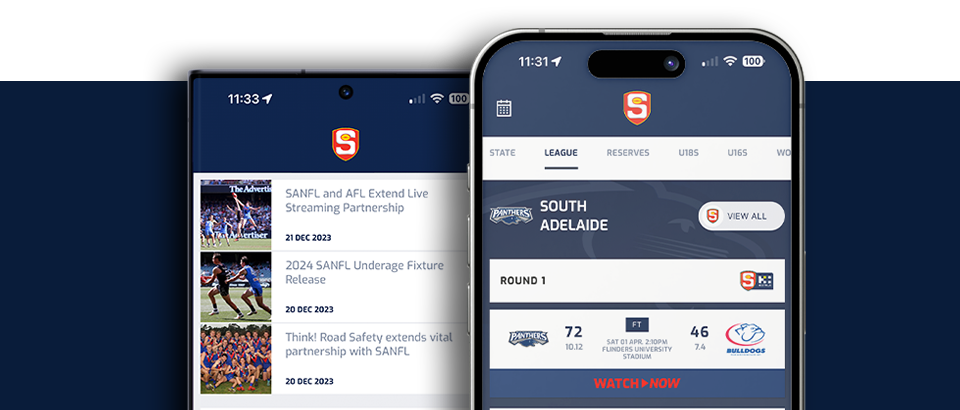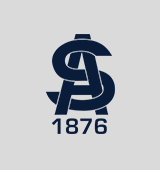
1877
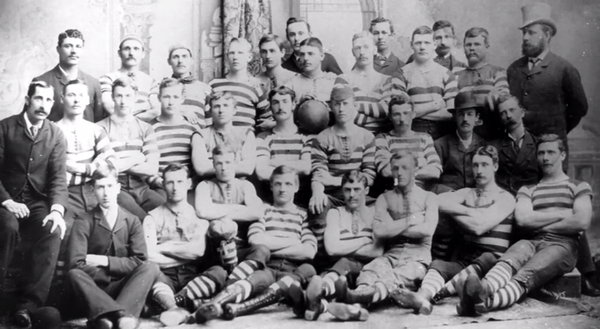
The South Australian Footballers' Companion published at the end of the 1877 season began with the comment: "it may indeed be chronicled in the annuals of South Australia that in the year 1877 football first took its place as a popular sport in the colonythe formation of an association towards the end of Aprilgave football an impetus such as it had never before."
Interestingly, the meeting at which the Association was formed took place a fortnight before a similar Association (the VFA) was formed across the border.
At the same meeting, when rules were being decided on, it was the South delegate, C.C. Kingston, who insisted that the ball used should be oval in shape, and not round, and that players should have to bounce the ball and not run with it as in rugby.
1885

At the annual general meeting of the South Adelaide Football Club in March 1885, the president, C.C. Kingston, drew attention to what he considered to be the lack of training at the club over the previous years; to help counter this, he offered a gold medal to the man who trained most carefully, and another for the player that was considered the best and most unselfish at the end of the season.
Such inducements must have worked in that year's four team competition, because South Adelaide, which had been equal second with Norwood in the previous year, finished on top at the end of the year with 11 wins and two draws from the 15 games played, with Ports in second place with just seven wins.
In his review of the season, Goalpost, writing in The Observer, asserted that South's premier position was "due entirely to their playing together and using their headunity has been their characteristic feature; their football has been of a consistent character, and they have given the most finished exhibition of the game."
It must have been a pleasant season for Iney Mehrtens as well, the only one of South's original premiership team of 1877 still playing.
1892

The 1892 season saw a five team competition in which sixteen games were played. From the first game of the season at Kengsington Oval, in which South scored 21.18 and kept Menindie scoreless, the blue and whites showed they were going to be a force to be reckoned with.
Ably led by J. Reedman, who was to captain the side for five if its six premierships in this decade and a century later to be chosen as captain of South Adelaide's 'Greatest Team Ever', they won fourteen and drew one of their matches.
They knocked the eventual runners-up Port Adelaide out of consideration for the premiership in a match in early September in front of 8,000 people at Adelaide Oval; it was a particularly rough game, with many behind the play incidents including some 'fisticuff business; in a final quarter in which South held Port scoreless to win 8.12 to 3.10.
Nonetheless, South's success was attributed to their discipline, their regular attendance at training and their willingness to listen to the skipper on the field which, the writer added, had been 'by no means a characteristic of them during the past few seasons.
1893

By 1893 the depression had started to bite, with high unemployment and banks failing, which in turn had affected football attendance and income; the South Adelaide Football Club remained solvent only through a personal guarantee that their president C.C. Kingston (then premier of South Australia), had given the Bank of Adelaide, the premiership race, however, was all over three matches before the end of the season, when the blue and whites beat the eventual runners-up, Norwood, in a fast, exciting match in which "South Adelaide played as they had never played before, marking brilliantly, kicking great distances, and playing as unitedly as the Labour people are on ballot-box day.'
Amongst South Adelaide's team members that year was also a wealth of cricketing talent John Reedman captained South Australia in both football and cricket, and played for Australia in 1894. Ernie Jones, a strong follower and goalshooter and interstate footballer, also played in a five test series as a fast bowler on his death in 1943, Wisden declared him to be 'the best fast bowler ever produced by Australia.' And there was also young Clem Hill, who went on to play 49 Test matches and to captain both South Australia and Australia.
1895
In a midseason match, South (2.5) went down to Port Adelaide (4.5) that was the only game the blue and whites lost for the whole year. In fact South's compete dominance of the competition was considered to be the main reason attendance at all matches had dropped off so much in 1895.
The press believed that 'it is doubtful whether ever before in South Australia there has been such a well balanced team playingevery man excelled himself, and the way they worked together was splendid.'
For that era, the team had been particularly cohesive over the first half of the decade, with 11 of the 1893 team, and 16 of the 1895 combination, still playing in 1895.
However if there was one player 'who stood out conspicuously amongst his fellows' in the colony that year, it was halfback flanker for South, Alf 'Shaver" Marlow.
The brother of the hard working secretary Frank Marlow who later became a great SANFL administrator, Alf played from 1890 to 1903 including the six premiership years, as well as representing the state in 1893, 1894 and 1901. He played a game ahead of his time, often running off the halfback line into attack, and was known for his cleverness, his speed, his dodging, and his cool judgement.
1896
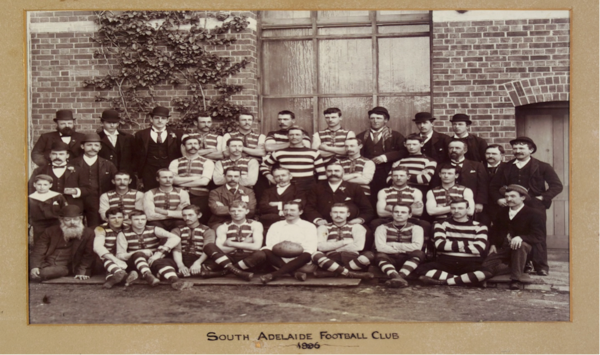
Again this season the press saw reason to bemoan the poor attendances, and to once again attribute them to 'the immeasurable superiority of the South's over the other twenties.'
Souths superiority saw them go through the season undefeated, winning 16 of the 18 matches played, and drawing the other two; to help balance outcomes, the North Adelaide and Native teams were permitted during this season to field three extra men when playing against South and the second side, Norwood.
There was also talk this year about the possible introduction of a district system to try to even out the competition. The general consensus was that the best player in the colony was clearly Sid Reedman, the brother of South's captain, Jack.
Sid generally played as a ruckman; he was 'blessed with a fine physique which he always made use of and got through his opponents when a less powerful man would have failed.'
A few years later, when the new zoning system forced jack to play for North Adelaide, the ruck clashes between the two brothers whenever South played North were said to be 'worth going miles to see.'
1898
South 8.8 (56) def. Port 4.8 (32)
After finishing one game behind Port Adelaide in 1897, the South camp was rocked before the end of the season by the death by typhoid of one of their young and upcoming stars, Julius Niehuus.
However, secretary Frank Marlow had been busy looking for recruits, and one of the new men was a fit and clever Bob Grierson, from North Melbourne, who made an immediate impression on the competition and was regarded at the end of the season as the best in the colony.
This was also the second year in which full forward Jack Kay topped the competitions goalkicking list.
South started the season by losing the first two matches, but once the team clicked into gear they did not drop another game. One feature of the year was the stability of their team, which week after week was made up of the same twenty another was the fact, as the press acknowledged, that 'they treated the spectators to exhibitions which for perfect passing and general cleverness have never been excelled in this country.'
At the end of season proper, a 'premiership' match was arranged between South and Port (who had finished in second position).
South won 8.8 to 4.8.
1899
South 5.12 (42) def. Norwood 2.2 (14)
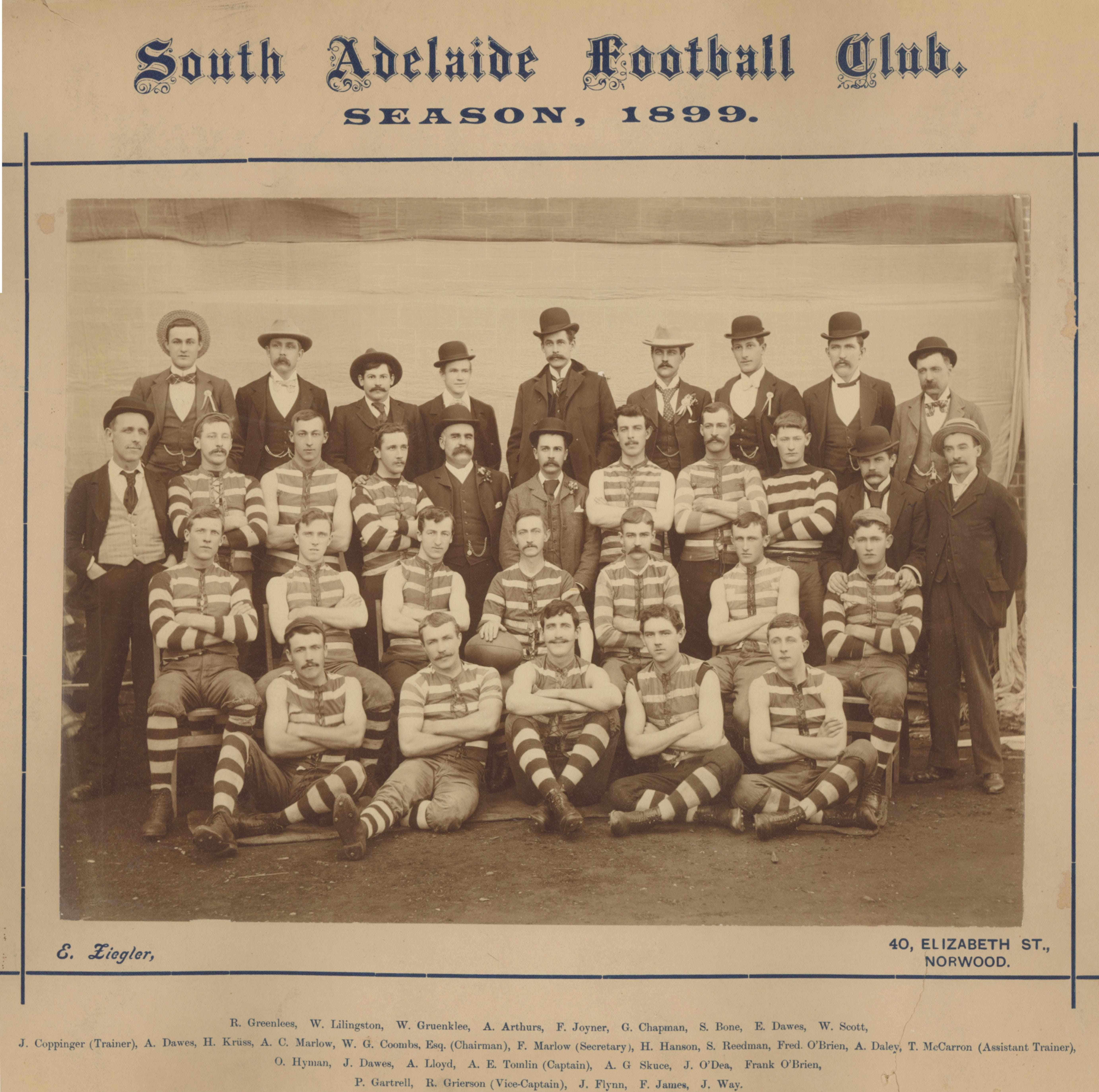
1899 saw a reduction in player numbers from twenty to eighteen, and was the long awaited year when the district system was introduced, with the aim of evening up the competition. South immediately lost the services of top goalshooter Jack Kay, long serving captain Jack Reedman and Ernie Jones (who both went on to captain North Adelaide), with Reedman also lifting West Adelaide from bottom to top in 1908, as well as Percy Kekwick, Ted McKenzie and G.C. 'Squasher' Barnes, who later captained Sturt, West Torrens and Norwood respectively.
However, South still had their premier recruiting ground of Christian Brothers College which in 1899 provided half of their team; the press said it was; 'the better half.'
With a new found emphasis on attacking football, and with Bos Daly kicking the association best of 32 goals for the season, South finished on top of Norwood, and then contested a 'play-off' match against them.
South were nine points up at halftime, with O'Dea dominating the ruck contests, and rover Bobby Grierson ('the best man of the year') taking full advantage of the hit outs. In the second half Norwood had even greater difficulty in holding off 'the clever combination of South, who were playing perfectly together,' and the 'Freshwaters' (as South were frequently called) went on to record a 28 point win.
1935
South 15.9 (99) def. Port 13.13 (91)

After finishing on the bottom of the table in 1934, South appointed Port Adelaide's Vic Johnson to the coaching position in 1935 and, ironically, came up against Port in the Grand Final.
After finishing second in the minor round and with Port winning the first semi-final convincingly, there were not many commenters who expected a South victory in the rematch in the Grand Final in memory.
South began strongly to lead 5.1 to 2.3 at the first break. In the second quarter, the lead changed a number of times in a fast and fiercely fought quarter with South having an 11 point margin at half time.
By the last break, that margin was 23 points, but South had to withstand a strong Port counter attack in the last quarter that brought them within two points, before kicking away to win 15.9 to 13.13
It had been a good year for the blue and whites the had found a real spearhead in Diddy Munro whose six goals in the Grand Final had given him 115 for the season, and Jack Cockburn had won the Magarey medal
1938
South 23.14 (152) def. Port 15.16 (106)
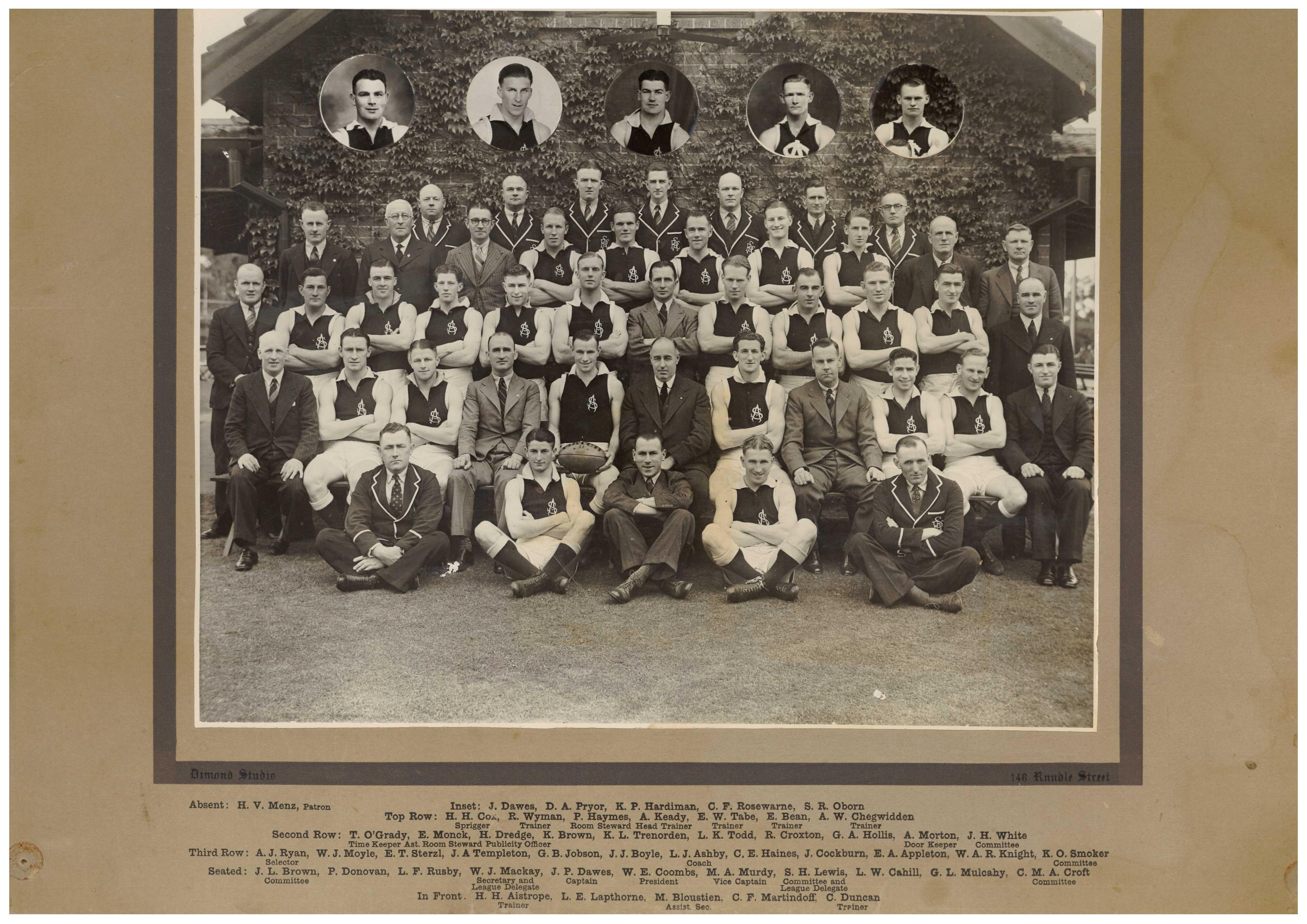
Finishing runners-up the previous year, South finished top of the 1938 minor round, losing only two matches, and then beating second placed Norwood in the semi-finals.
In the Grand Final they faced off once more against Port in front of 33,000 spectators, who were thrilled by the fast, open football and long kicking of the first half, which saw the scores tied at 9.5 a piece at half time.
By the five minute mark of the third quarter, however, the match was all over. South, fit and full of running, had rattled on five goals in that time, inspired by Len Lapthorne's mercurial roving, and went on to post another seven for the term in what was described as 'an electrifying third quarter burst which for sheer brilliance has never been surpassed in any previous league football Grand Final.'
Laurie Cahill's speed, determination and precision on the wing made him unbeatable and best on ground, and the club's Mid-North recruits in Jack Boyle, Jack and Jim Dawes, Jack Cockburn, Don Pryor, George Jobson and Laurie Rusby (with his 5 goals) had also figured prominently in the 23.14 to 15.16 win, in what is generally regarded as South's best team ever.

1964 was the twentieth season since the SANFL competition had recommenced after WWII; in eighteen of those years the newly named Panthers has finished bottom or second to bottom, only winning two of their matches in the previous year.
The new season didn't promise much either, as there had only been two new additions to the training list tough little Alan White, and captain coach Neil Kerley.
Early on, however, it was obvious that Kerley had added a new dimension of keenness and aggression, and in front of minor round crowds that touched 30,000, South finished with a 17-3 record, the same as Port Adelaide, the previous year's premiers whom they were to meet in the Grand Final.
In front of 56,000 spectators, South held Port goalless in the first half, and prevailed over another final term Port fightback that saw them get to within 13 points before South kicked away to win 9.15 to 5.12.
Individual efforts like David Kantilla's third quarter leap and mark over a pack in the goalsquare at the river end, and Alf Skuse's elusive running game, blended with a disciplined team effort that had visiting Melbourne coach Ron Barassi amazed by the speed and handballing skills of 'Kerley's Kids.'

